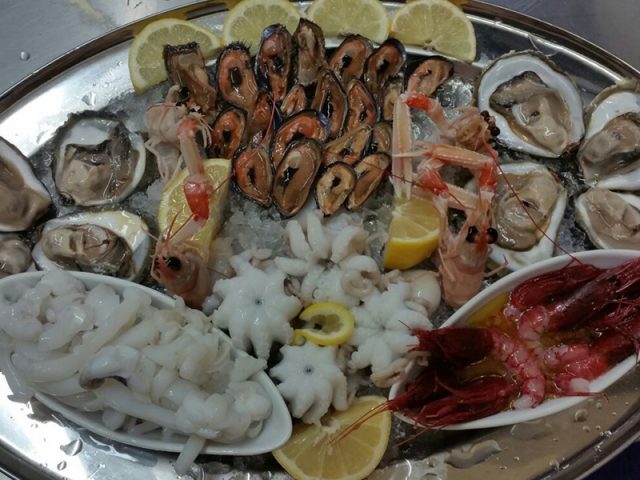Neromoro Nicodemi, the dark side of Colline Teramane (1)
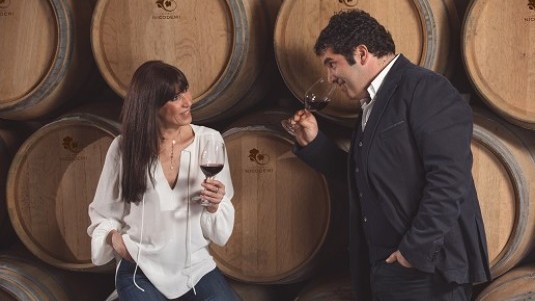
Alessandro and Elena Nicodemi run their family estate with conviction and, as Elena told us, professionalism.
In a region like Abruzzo, which is perceived by wine lovers as a kind of entity unto itself, it is not easy to talk about zones. Nevertheless, not only is this a valid discussion but also a useful one, given that certain zones have particular characteristics.
A case in point is the area of Colline Teramane, in the northern part of the region, which has stood with the establishment in 2003 of a DOCG appellation of the same name. The Montepulciano d’Abruzzo here, while not losing any of its proverbial trait of being generous and pleasingly rustic/elegant, has tannins that are almost Tuscan-esque and an aroma that s more floral.
Since the creation of the DOCG appellation, one of the estates that has come into its own is Nicodemi, in Notaresco, which is run by siblings Alessandro and Elena Nicodemi. The estate originally was a country farm where they raised livestock, grew crops and produced wine and olive oil. Then, in the late 1960s, Bruno Nicodemi, the father of Alessandro and Elena, decided to turn it into a wine estate.
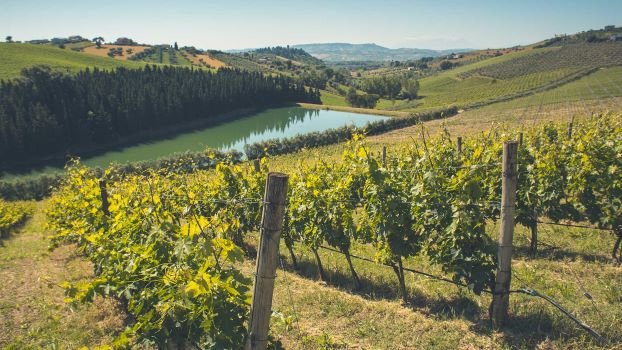 The estate, as we know it today, began to take form in 1970 with the decision to cultivate only Montepulciano and Trebbiano and to bottle the wine that was made, something that was not commonplace in Abruzzo at the time. After Bruno Nicodemi died, in 2000, his children took over and immediately began to make improvements. This included modifying pruning methods to revamping the old pergola Abruzzesi trellises and even renovating certain vineyard parcels and pinpointing those that were particularly suited to produce a cru wine. They expanded their line of wines and, above all, immediately focused on those classified DOCG Colline Teramane.
The estate, as we know it today, began to take form in 1970 with the decision to cultivate only Montepulciano and Trebbiano and to bottle the wine that was made, something that was not commonplace in Abruzzo at the time. After Bruno Nicodemi died, in 2000, his children took over and immediately began to make improvements. This included modifying pruning methods to revamping the old pergola Abruzzesi trellises and even renovating certain vineyard parcels and pinpointing those that were particularly suited to produce a cru wine. They expanded their line of wines and, above all, immediately focused on those classified DOCG Colline Teramane.
The estate today has 38 hectares of land in the hills with a single-body, 30ha vineyard. It has a southeast exposure, sits at an altitude of around 300m above sea level with the Gran Sasso massif at its back and the sea some 10km away. Here the vines benefit from significant diurnal temperature variations and breezes that allow for the healthy ripening of the grapes. The calcareous-clay soil has a medium density and is rich in calcium (a particular trait of Val Vomano) which gives the skins a nice thickness and consistency.
The estate’s showcase wine is Neromoro, a select Montepulciano d’Abruzzo Colline Teramane that is produced with the grapes of a single vineyard that has an eastern exposure and where the almost 50-year-old vines are tendone-trained. In particularly abundant years, the vines are thinned out between the end of July and beginning of August leaving only one bunch per shoot with at most 8-10 bunches per vine. Given the exuberance of the varietal and the harshness of the tannins, defoliation is never excessive but kept to the minimum necessary in order to avoid the risk of powdery mildew while impeding the synthesis of “harsh” tannins by keeping the grapes exposed to the sun.
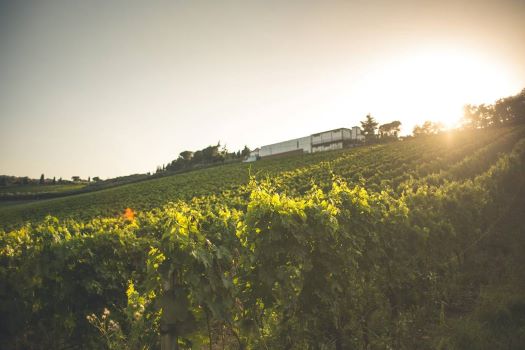 Harvest normally takes place before mid-October and it is done by hand, using baskets holding 20kg, waiting until not only have the skins ripened to the best but also the interior, which with Montepulciano is not at all easy to achieve.
Harvest normally takes place before mid-October and it is done by hand, using baskets holding 20kg, waiting until not only have the skins ripened to the best but also the interior, which with Montepulciano is not at all easy to achieve.
Following destemming, cold maceration takes place in stainless steel vats for around two days to allow the aromas to establish themselves. Normal maceration lasts no more than 8-10 days. In the initial phase, the must ferments at a temperature of around 34°C, for the greatest extraction of polyphenols from the skins, after which the temperature is reduced to around 26-27°C and the must continues to ferment for another 3-4 days. After this the wine is drawn off and fermentation is completed off the skins.
Throughout all the stages of fermentation, there is daily pumping over after which there are two decantings before the wine is transferred into barriques where it undergoes malolactic fermentation. The wine then is left “dirty” and remains on the less to allow the tannins to polymerize.
Neromoro matures for 18 months in French-oak barriques (50% new wood, 50% used). During this period there is weekly paddling. The wine is then bottled without any filtration nor clarification.
We had a chat with Elena Nicodemi to get a better picture of the estate.
DoctorWine: Tell us something about yourself and your brother.
Elena Nicodemi: Our roots are in Abruzzo on the side of our paternal grandparents but we grew up in Rome where our family moved before the Second World War. When Alessandro and I took over the estate, in 2000, we were both young with experiences very different from the world of wine. Alessandro studied business and economics, while I studied architecture. Up until then we had only lived in the city while our time in the country was limited to playing in the vineyards during the summer. But a turn of events (the premature death of our father) suddenly catapulted us here and we had the full responsibility of the estate on our shoulders. We grew up with those vines and the estate was more in our blood than we realized at the time. I remember how we did not say much, just looked around and buckled down to work… perhaps with that healthy inexperience and great enthusiasm typical of youth.
DW: How did you organize things?
EN: We split up responsibilities according to our respective interests and personalities. I have a more versatile personality and I love to tackle new experiences and so I focused on sales which involved travelling the world considering that we export 80% if our production. In collaboration with our young and dynamic estate team, I also follow all phases of production. Alessandro needs to have everything under control and for this reason opted for staying on the estate to, for the most part, handle its administrative affairs. He is the one who, on the frontline, resolves any problem and is the go-to person for all the estate’s collaborators.
DW: When you began to produce wine did you have point of reference, a model you aspired to?
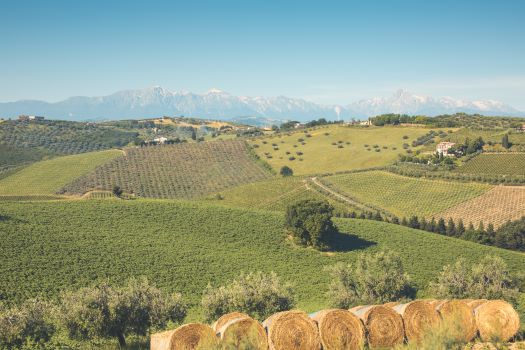 EN: When we began to make wine we first of all began to taste the wines of our fellow producers in Abruzzo and beyond. More than seek a model to aspire to, we needed to understand what was being produced at the estate at the time and, above all, give these wines an identity that would from then on make them our wines, mine and Alessandro’s. And it was in this context that we understood we would discover our reference point through the close observation of the grapes we cultivated. We understood that Montepulciano is a varietal with few compromises, it has a thick skin and is generous in the size of the grape and bunches. It also has a high concentration of polyphenols and a nice tannic structure, with good aromas and, above all in hot years, high levels of sugar and thus alcohol. Due to its structure and boldness, as well as its high yield, in the 1950s it was a “relief” wine, one used in blends to give wines from other areas the structure they may have lacked. In the 1980s, only a few estates we seeking to produce a wine that reflected the territory.
EN: When we began to make wine we first of all began to taste the wines of our fellow producers in Abruzzo and beyond. More than seek a model to aspire to, we needed to understand what was being produced at the estate at the time and, above all, give these wines an identity that would from then on make them our wines, mine and Alessandro’s. And it was in this context that we understood we would discover our reference point through the close observation of the grapes we cultivated. We understood that Montepulciano is a varietal with few compromises, it has a thick skin and is generous in the size of the grape and bunches. It also has a high concentration of polyphenols and a nice tannic structure, with good aromas and, above all in hot years, high levels of sugar and thus alcohol. Due to its structure and boldness, as well as its high yield, in the 1950s it was a “relief” wine, one used in blends to give wines from other areas the structure they may have lacked. In the 1980s, only a few estates we seeking to produce a wine that reflected the territory.
Thus, more than seeking a model we sought a “concept” to strive for. On the one side was the concept of the terroir in which the intervention of the “enlightened” producer was that of creating a wine that was product of a territory. We thus sought to respect the Montepulciano fruit and its propensity to age as a means to make the territory of Colline Teramane recognizable. We also sought to lighten the wines up, creating wines that were distinguished by their dynamism, the freshness of the fruit and their elegance. The phenolic content of Montepulciano makes it difficult to make it into wine especially if the yield has been very low, thus with great concentration in the skins which creates structure. The wine is subject to aromatic deviations that seem crude and can make it difficult to drink even after aging long. If adequate measures are not adopted, the wine from hot years can become opulent and difficult to drink, while in wet years they can have herbaceous aromas that are difficult to interpret in the glass. It is for these reasons a certain awareness is essential in winemaking.
Our challenge begins with striking a balance in the vineyard between the fruit and the foliage in order to arrive at harvest with the fruit ripe but not overripe. We never excessively extend macerating on the skins and we never forget, in every stage of winemaking and maturating, whether it be in in wood or stainless steel, to oxygenate the wine correctly. This because its level of concentration often tends to make the flavor of the wine closed and we never want it to lose the fruity essence which links it to the grape, even after aging for years.
Tomorrow we will continue our chat with Elena Nicodemi and taste her wines.
Related Products
| Product | Producer | Date of publication | Author | Read | |
|---|---|---|---|---|---|

|
Fattoria Nicodemi
|
03/05/13 | Redazione |
Alessandro and Elena Nicodemi, who are Romans by birth but have chosen Abruzzo as their home, have been successfully running their family winery for some years now. It is located in Notaresco, in Val... Leggi tutto |

 Italiano
Italiano







